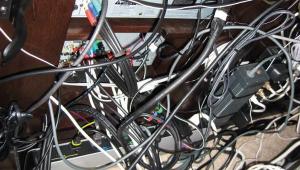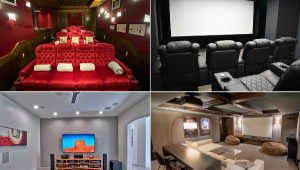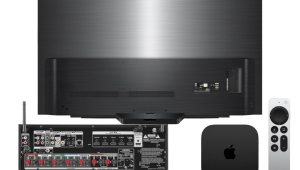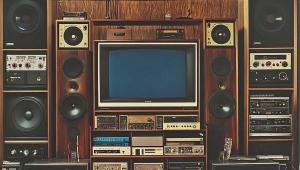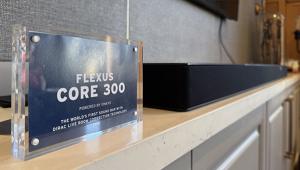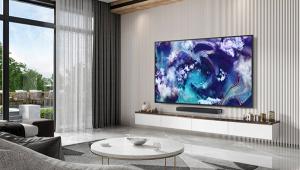Regarding dissimilar subwoofers in a space, I'd heard elsewhere that using different subs in a room(I don't know if the subs mentioned above are equal size) can cause odd conflicts with the sound waves they produce. Heck, I'd heard that's a problem even with same-sub setups. I couldn't gather from your response whether you are suggesting setting the subs perpendicularly from each other. Are you? And if so, how does this mitigate wave problems at the listening position(s)?
Satellites, Subwoofers, Projector Placement

A satellite signal comes into your house and goes to the satellite receiver via coax, right? Why can't you connect the coax directly to an HDTV and get a high-def signal? Also, why do Dish and DirecTV advertise "full HD" when the signal is 1080i?
Ashley Hill
The satellite signal coming into your house via coax includes both HD and SD programs, all mixed together. To see only one program, you need a tuner to select the channel you want. TVs typically have two types of tuners built in: over-the-air (otherwise known as ATSC) and unencrypted digital cable (otherwise known as QAM), so you can connect an ATSC antenna or digital-cable coax directly to the TV, and its tuner will select the channel you want.
However, the TV cannot select encrypted cable channels, which are typically the premium channels such as HBO. To see those channels, you need a set-top box or CableCard from the cable company, which unscrambles those channels and lets you select one to view. Similarly, no TV has a satellite tuner built in, so you need one from the provider.
As for Dish and DirecTV advertising that they're "full HD," 1080i actually is full HD in that it represents a pixel grid of 1920x1080, even though each frame is sent in two passes rather than in one pass as with 1080p. This advertising slogan might be slightly misleading, but it isn't technically incorrect.
Substitute Sub
I have a home theater with a Denon AVR-5800 receiver, NHT speakers, and an NHT SW2P subwoofer. When the sub started to give me trouble, I purchased a Definitive Technology Supercube subwoofer, which I love. Since then, I discovered that the tube from the front port of the NHT sub was loose, and I was able to fix it. My question is this: Can I use the NHT sub with my new Def Tech, and how should I install it? My room is 20x25 feet with a high cathedral ceiling.
Paul Guyton
You can certainly use both subs in your system. The Denon AVR has only one subwoofer output, so you need to use a simple splitter to feed both subs. Alternatively, you might be able to daisy-chain the subs, though I don't know that for sure. Assuming you have a rectangular room, start by putting each sub at the half or quarter point of two walls, maybe the front and one side wall. You can then fine tune the position from there, but that's a great place to start.
Update: It turns out that putting the subs at the half points of opposing walls is actually better than on adjacent walls as I originally stated. This placement tends to cancel certain room modes, and the mean spatial variance (a measure of seat-to-seat variation) is much lower than with a single sub. However, it also amplifies other modes, a situation that can be helped with acoustical damping and equalization.
In addition, the subs should be as close to the same size and output as possible. Your NHT SW2P has a 10-inch driver, but you don't say which model of Def Tech SuperCube you have. The SuperCube I has a 10-inch driver and two 10-inch passive radiators, while the SuperCube II and III use smaller drivers and radiators. You'll get the best results if the Def Tech is a SuperCube 1.
Keystone Korrection
In your answer to the question about keystone correction, I believe you did the reader a disservice when you said, "You should mount the projector so that its light path is perpendicular to the screen."
I agree it's best when the projector's light path is perpendicular to the screen, but in many rooms, this would probably put the projector in a very awkward location unless it could be mounted on the back wall. Otherwise, assuming a room with an 8-foot ceiling and the screen's center 3 to 4 feet above the floor, that would put the projector 3 to 4 feet above the floor. This would put it right where a seat would be or in an aisle between seats. It also means using a very long suspension structure if the projector is hung from the ceiling or a tall column structure if it's mounted on the floor.
I suggest that a better answer would have been to say, "If possible, the projector should be located so it's light path is perpendicular to the screen."
I have a 10-foot ceiling in my home theater. My screen is 8 feet wide by 6 feet high with its center approximately 5.5 feet above the floor. Locating the projector so its light path is perpendicular to the screen is not desirable at all.
Richard Polacek
Actually, I didn't say the projector should be mounted at the same height as the center of the screen, only that it should be mounted so the light path is perpendicular to the plane of the screen. In many cases, the projector can be at the same height as the top of the screen when ceiling-mounted, which avoids the problems you cite.
However, now that you mention it, I see how I could have worded my response better. If the projector is mounted at the same height as the top of the screen, the light path is not perpendicular to the screen—it shoots downward. In most cases, the projector's light engine is aligned in such a way that this position still results in a rectangular image if the lens axis—an imaginary line that runs through the center of the lens assembly—is perpendicular to the plane of the screen.
So to be completely accurate, I should have said that a projector should be mounted so its lens axis is perpendicular to the plane of the screen. My point is to avoid using the projector's electronic keystone feature if at all possible, since it degrades the picture quality.
Another critical factor in this discussion is the projector's lens-shift function, which moves the image up or down and side to side without affecting the rectangularity of the image. Lens shift provides a lot of flexibility in placement while keeping the lens axis perpendicular to the plane of the screen, thus avoiding the dreaded keystone correction. Most projectors provide this function, but not all—if it's missing, that's a deal-breaker for me.
If you have a home-theater question, please send it to scott.wilkinson@sorc.com.
- Log in or register to post comments

Nathan, I've never heard that two or more different subs in a room can cause problems just because they are different sizes, brands, or whatever. All subs produce low-frequency sound waves, which can cause problems, but not because of the subs themselves. The problems arise in the interaction between the subs and the room.I am suggesting that the subs be placed perpendicularly, although this may not really matter. Mostly, I'm following Dr. Floyd Toole's research that shows the best place for subs in a rectangular room is at the half or quarter points along the walls, which yields the smoothest bass.

A couple of clarifications to the answer you provided Ashley about satellite are needed.A satellite receiver needs to do the following tasks before its signal is usable by any display:1-Provide phantom power to the LNBs (Low Noise Block down converters) on the dish2-Demodulate the satellite signals (12.2-12.7 GHz)3-Tune to the appropriate channel (choose satellite, transponder, polarity, & channel)As for full HD, both DISH and Direct do provide 1080p content on selected PPV or on demand channels.4- Decode the channel (MPEG-2 or MPEG-4)5-Decrypt any encrypted channel contentTV's are designed for terrestrial over the air or cable ATSC signals and are not equipped to handle all of the above tasks.

What is missing from the Keystone Korrection discussion is lens shift, which makes it possible to mount the projector a few inches from and parallel to the ceiling and not have the top half of the image on the on the ceiling. See http://www.projectorreviews.com/advice/general/opticalkeystone.php for a description of the function.

Hi Nathan and Scott. In regards to the dissimilar subwoofers in a space, my understanding of Dr. Floyd Toole's research is that if you have 2 subs you should place on opposite walls and not on adjoining walls. In the original response it was mentioned that "start by putting each sub at the half or quarter point of two walls, maybe the front and one side wall" which, according to the research, will not give you the effect you would expect. Having the subs on opposite walls in phase allows the waves to rise and fall together which destructively changes the wave patterns and gives you less boomy, tighter, more punchy bass. To this affect, you would have to assume (I haven't read the whole book) that to generate the same wave pattern the subs need to of at least the same size and power output, but I could be wrong. Sorry to nitpick. BTW Scott, loving "Home Theatre Geeks"!!

Lawrence, you're entirely correct. My original response was based on an incomplete understanding of Toole's findings, which he set me straight about when he was on Home Theater Geeks. (BTW, thanks for the kind words about that!) And as I recall, he did say the subs should be as identical as possible. I'll update my main response accordingly.

